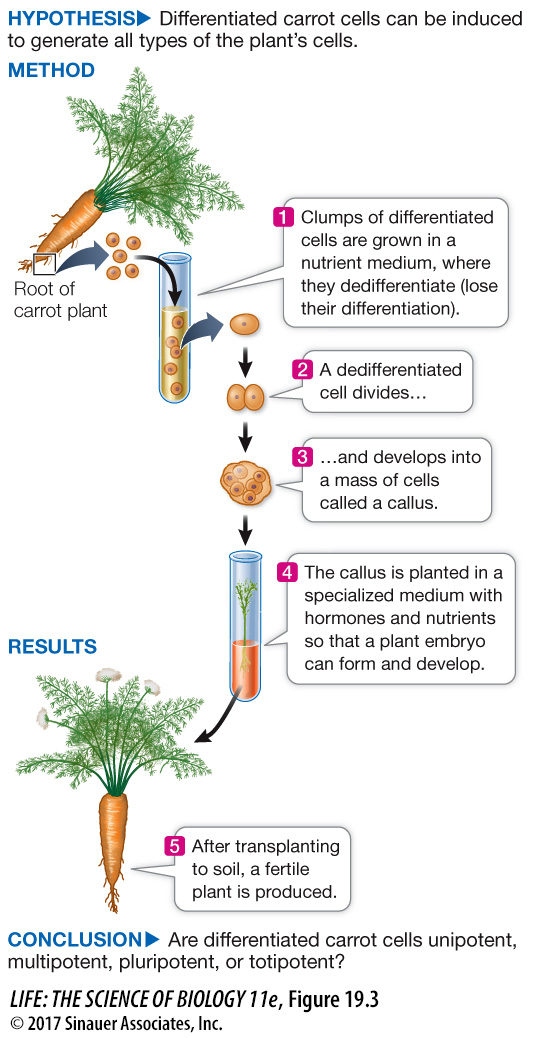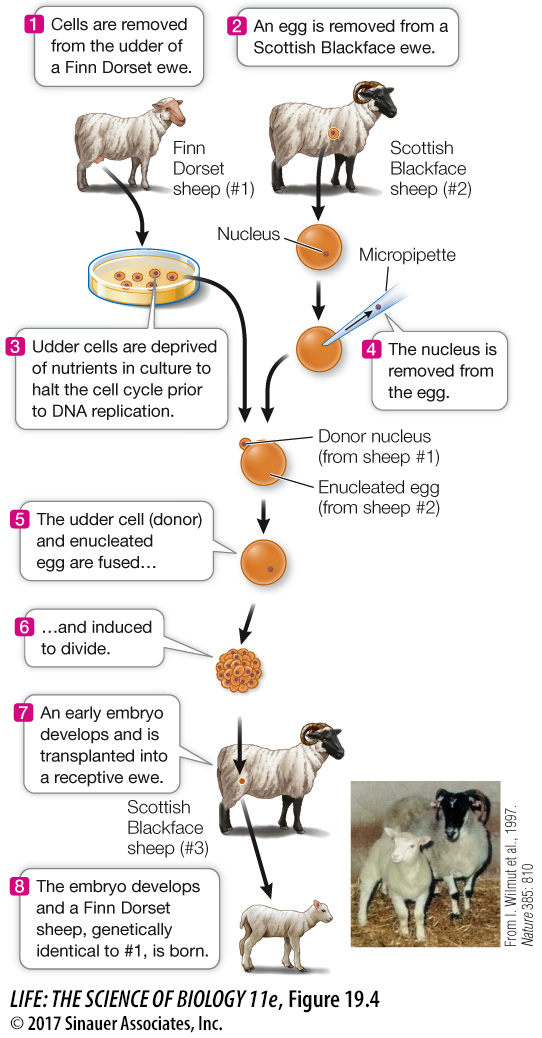Cell differentiation is sometimes reversible
Once a cell’s fate is determined, the cell differentiates. However, under the right experimental conditions, a determined or differentiated cell can become undetermined again. In some cases the cell can become totipotent, able to form an entire organism with all of its differentiated cells.
PLANT CELL TOTIPOTENCY A carrot root cell normally faces a dark future. It cannot photosynthesize and generally does not give rise to new carrot plants. However, in 1958 Frederick Steward at Cornell University showed that if he isolated cells from a carrot root and maintained them in a suitable nutrient medium, he could induce them to dedifferentiate—
experiment
Figure 19.3 Cloning a Plant
Original Paper: Steward, F. C., M. O. Mapes and K. Mears. 1958. Growth and organized development of cultured cells. II. Organization in cultures grown from freely suspended cells. American Journal of Botany 45: 705–
When cells were removed from a plant and put into a medium with nutrients and hormones, they lost many of their specialized features—

Cloning an entire carrot plant from a *differentiated root cell showed that the root cell contained a complete carrot genome, and that under the right conditions, the cell and its descendants could express the appropriate genes in the right sequence to form a new plant. Many types of cells from other plant species show similar behavior in the laboratory, and in some cases in nature (asexual reproduction). Being able to generate a whole plant from a single cell in the lab is invaluable in agriculture and forestry. For example, trees from planted forests are used in making paper, lumber, and other products. To replace the trees reliably, forestry companies regenerate new trees from the leaves of selected trees with desirable traits. The characteristics of these clones are more uniform and predictable than those of trees grown from seeds.
*connect the concepts Plant cell differentiation from stem cells is discussed in Key Concept 33.3.
NUCLEAR TOTIPOTENCY IN ANIMALS Animal somatic cells cannot be manipulated as easily as plant cells can. However, as you saw with the transplantation experiments on sea urchins, the cells of very early animal embryos are totipotent. In humans this totipotency permits genetic screening (see Key Concept 15.4) of an embryo. One or two cells can be removed from the embryo and examined to determine whether a certain genetic condition is present. Because of their totipotency, the remaining cells can develop into a complete embryo, which can be implanted into the mother’s uterus, where it develops into a normal fetus and infant. A later animal embryo cell won’t develop into a complete organism, but the nucleus of such a cell has the genetic potential to do so.
Nuclear transfer experiments demonstrate that the genetic information from a single animal cell can be used to create cloned animals. Robert Briggs and Thomas King performed the first such experiments in the 1950s using frog embryos. First they removed the nuclei from unfertilized eggs, forming enucleated eggs. Then, with very fine glass needles, they punctured cells from early embryos and drew up parts of their contents, including the nuclei. Each nucleus was injected into an enucleated egg. They stimulated the eggs to divide, and many went on to form embryos, and eventually frogs, which were clones from the original implanted nuclei. These experiments led to two important conclusions:
No information is lost from the nuclei of cells as they pass through the early stages of embryonic development. This fundamental principle of developmental biology is known as genomic equivalence.
The cytoplasmic environment around a cell nucleus can modify its fate.
More recent studies have demonstrated that a cell from a fully developed animal can be induced to dedifferentiate and give rise to an entire new individual. In 1996 Ian Wilmut and his colleagues at the Roslin Institute in Edinburgh cloned the first mammal by somatic cell nuclear transfer. This method involves the fusion of a somatic (nonreproductive) cell from an adult animal, containing the donor nucleus, with an enucleated egg. The fully differentiated donor cells were isolated from a Finn Dorset ewe’s udder and starved of nutrients for a week, halting the cells in the G1 phase of the cell cycle. One of these cells was fused with an enucleated egg from a Scottish Blackface ewe, and this fused cell began to divide. After several cell divisions, the resulting early embryo was transplanted into the womb of a surrogate mother. Eventually a lamb named Dolly was born (Figure 19.4). Dolly showed all the characteristics of a Finn Dorset sheep: she carried the same genetic material as the nuclear donor, and thus was a clone of that donor.
research tools
Figure 19.4 Cloning a Mammal
The experimental procedure described here produced the first cloned mammal, a Finn Dorset sheep named Dolly (shown on the left in the photo). As an adult, Dolly mated and subsequently gave birth to a normal offspring, thus proving the genetic viability of cloned mammals.

A work with the data exercise that accompanies this figure may be assigned in LaunchPad.
The production of Dolly demonstrated that a fully differentiated cell from a mature organism can revert to a totipotent state, and that this cell can be used to create a new animal. More than 20 animal species, including cats, deer, dogs, horses, pigs, rabbits, and mice, have since been cloned by nuclear transfer. There are several reasons to clone animals:
Expansion of the numbers of valuable animals: One goal of Wilmut’s experiments was to develop a method for cloning transgenic animals with useful phenotypes. For example, a cow was genetically engineered to make human growth hormone in her milk. This animal was then cloned to produce additional cows that do the same thing. Only 15 such cows are needed to supply the world’s demand for this medication, which is used to treat short stature caused by growth hormone deficiency.
Preservation of endangered species: The mouflon, a small sheep native to the European islands of Sardinia and Corsica, was the first endangered animal to be successfully cloned. Cloning may be the only way to save some endangered species with low rates of natural reproduction, such as the giant panda.
Perpetuation of pets: Many people get great personal benefit from pets, and the death of a pet can be devastating. Companies have been set up to clone cats and dogs from cells provided by their owners. Owners have paid more $100,000 each to have their pets cloned. Of course, the behavioral characteristics of the beloved pet, which are certainly derived in part from the environment, may not be the same in the cloned pet as in its genetic parent.